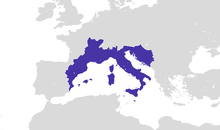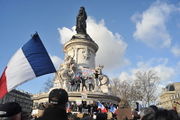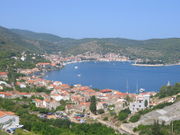Nation/Calicathia
| Calican Republic République calicienne (French) Repubblica calicana (Italian) Republika Kaliska (Croatian) República calicà (Catalan) Republica calicana (Spanish) |
||||||
|---|---|---|---|---|---|---|
|
||||||
| Motto: "Liberté et prospérité pour l'éternité" (French) "Libertà e prosperità per l'eternità" (Italian) "Sloboda i Prosperitet za Vječnost" (Croatian) "Llibertat i prosperitat per l’eternitat" (Catalan) "Libertad y prosperidad por la eternidad" (Spanish) "Liberty and Prosperity for Eternity" |
||||||
| Anthem: "Notre belle patrie" (French) "Nostra bella Patria" (Italian) "Lijepa naša domovino" (Croatian) "Nostra bella pàtria" (Catalan) "Nuestra bella patria" (Spanish) "Our Beautiful Homeland" |
||||||
Territory of the Calican Republic (dark blue)
|
||||||
Location of European Calicathia (dark blue)
|
||||||
| Capital and largest city | Térmle | |||||
| Official languages |
|
|||||
| Recognised minority languages |
|
|||||
| Demonym | Calican | |||||
| Government | Unitary semi‑presidential republic | |||||
| - | President | Louis Alfonse Gaglione | ||||
| - | Prime Minster | Célia Garreau | ||||
| - | President of the Senate | Estelle Rodin | ||||
| - | President of the Chamber of Deputies | Emiliano Curci | ||||
| Legislature | Parliament | |||||
| - | Upper house | Senate | ||||
| - | Lower house | Chamber of Deputies | ||||
| Establishment | ||||||
| - | End of WWIII | 2014 | ||||
| - | French settlement of Italy | c. 2264 – 2514 | ||||
| - | Republic established | 4 May 2514 | ||||
| Area | ||||||
| - | Total | 839,268 km2 324,043 sq mi |
||||
| - | European Calicathia | 755,412 km2 291,666 sq mi |
||||
| Population | ||||||
| - | 2635 census | 106 022 898 | ||||
| Currency | Calican franc (₣) (CRF) |
|||||
| Time zone | CET (UTC+1) | |||||
| - | Summer (DST) | CEST (UTC+2) | ||||
| Date format | dd/mm/yyyy | |||||
| Drives on the | right | |||||
| Calling code | +77 | |||||
| Patron saint | Saint Genevieve | |||||
| Internet TLD | .cal | |||||
Calicathia (French: Calicathie; Italian: Calicathia; Croatian: Kalikatija; Catalan: Calicatia; Spanish: Calicathia), officially the Calican Republic (République calicienne; Italian: Repubblica calicana; Croatian: Republika Kaliska; Catalan: República calicà; Spanish: Republica calicana), is a country with territory in Europe and several overseas regions. The European area of Calicathia is made of five contiguous parts, with (west to east) Aragon located on the eastern Iberian Peninsula, Occitania consisting of the Massif Central region, the eastern Garonne Valley, the Rhône Valley and the Mediterranean Coast of France, Italia consisting the northern half of the Italian Peninsula and parts of the Alps, the Mezzogiorno comprising of the southern section of the Peninsula and the island of Sicily, Adriacia located in the Balkans in Southeast Europe, the islands of Sardinia, Corsica and the Balearic Islands, and also Gibraltar. Overseas Calicathia includes Guiana in continental South America and several islands in the Atlantic and Pacific oceans. Calicathia spans 839,268 square kilometres and had a total population of over 106 million people as of the 2635 census. It is a unitary semi-presidential republic with the capital in Térmle, the nation's largest city and one of its largest cultural and commercial hubs. Other major settlements include Lyon, Marseille, Milan, Naples, Palermo, Rome, and Zagreb.
After the Third World War, Southern Italy was left depopulated due to the nuclear fallout from detonations across Europe and remained mostly uninhabited throughout the nuclear winter which ensued subsequently. The nuclear winter would last for around 250 years in the most devastating global ecological event in recorded history. This saw much of the world's population die due to starvation, disease and extreme weather conditions. Humanity began to recover towards the final decades of and immediately following the winter as conditions began to improve. Native population numbers in what would become Calicathia steadily began to increase. Significant growth in population did not come until independent French settlers from Southern France began to cross the Western Mediterranean, around the islands of Sicily and Corsica to settle in the Mezzogiorno region of Italy. The first major settlements to be reestablished by these settlers include Naples, Palermo, Reggio di Calabria and Salerno, all located on the Tyrrhenian coast. The two and a half centuries prior to Calicathia's foundation would see gradual redevelopment of the region, including the reestablishment of the local Italian populations. The Calican Republic was established on 4 May 2514, led by Auguste Baniere, a late settler born in Marseille on 7 June 2478.
Contents
- 1 Etymology
- 2 History
- 2.1 Antiquity and Middle Ages (6th century BC–15th century AD)
- 2.2 Early modern period (15th century–17th century)
- 2.3 Revolutionary France and Italian unification
- 2.4 Napoleon and 19th century (1799–1914)
- 2.5 The First and Second World Wars and Cold War (1914–1992)
- 2.6 Postmodern era and the Third World War (1993–2014)
- 3 Geography
Etymology
Calicathia was named by its founder, Auguste Baniere. The name Calicathia originates entirely from Greek. Part of the name comes from the Greek kallithea (καλλιθέα), meaning "the best view". Baniere inserted cath into the name of the country because of not only his devotion to the Catholic faith and thought that Calicathia was a new promised land but also due to the original root of the word catholic. In Greek katholikos (καθολικός) means "universal", as he believed that Calicathia was a place for all people.
History
Antiquity and Middle Ages (6th century BC–15th century AD)
The area which is now continental European Calicathia was once inhabited by Celtic people. The region known as Magna Graecia was populated by Greek settlers in from the 8th century BC onwards. The Romans expanded into the area of the Mezzogiorno between the years of 338 BC and 218 BC after the Second Punic War. Modern Adriacia was conquered between 44 BC to 14 AD after the death of Augustus, the first Roman emperor. Gaul was annexed by Rome in 51 BC until its fall to the Franks in 486, eventually forming the Kingdom of France. During the 7th century AD, Slavic people began arriving in present-day Adriacia, becoming the South Slavs, composing of Bosniaks, Croats, Serbs and Slovenes. The Ottomans brought Islam to the region of Bosnia and Herzegovina, after being annexed in the 12th century, mainly changing the culture of the people.
Early modern period (15th century–17th century)
Italian culture, since classical times, and French culture, during the Renaissance, have flourished and have arguably been the root of the culture of the entirety of the western world. The renaissance began in Italy and spread over the rest of Europe, increasing interest in science exploration and art. Famous Italian scholars became known at this time, including Leonardo da Vinci and Galileo. Italian explorers Marco Polo and Christopher Columbus were the first to discover new routes to East Asia and the New World, the Americas. This led to the scientific, political and military dominance of Europe over the entire world.
Revolutionary France and Italian unification
In the late 18th Century, the French Revolution overthrew its absolute monarchy and established one of modern history's earliest and most powerful republics. This subsequently led to the spread of republican ideas all over the world in one of the largest eras of political upheaval in modern times. In the mid 19th century, a rise in Italian nationalism led to an era of revolution whose participants sought the formation of a unified Italian state. After many unsuccessful tries, the Kingdom of Italy was formed in 1861, rapidly industrialising and establishing a colonial empire.
Napoleon and 19th century (1799–1914)
The First French Empire, led by Napoleon, was established in the 19th century and shaped the history of the continent with the Napoleonic Wars. He seized power of the republic in 1799. As many European powers declared wars on Napoleon's new empire, his armies conquered most of the European continent, with notable victories being at Austerlitz and Jena–Auerstedt. Napoleon established puppet kingdoms all over Europe, appointing his own family members as monarchs. The spread of this empire brought with it the adoption of French revolutionary ideals such as the Metric system and the Declaration of the Rights of Man. The decline of Napoleon came during his Russian campaign, after which he was exiled to the island of Elba in the Tuscan Archipelago. His brief return only ended in his demise, being defeated at the Battle of Waterloo against the British, Dutch and Prussian Seventh Coalition. He would be exiled to Saint Helena, where he would remain until his death at age 51. The reinstated monarchy was overthrown in the July Revolution of 1830, subsequently forming the July Monarchy and Second Republic. The French Second Empire led by Napoleon's nephew would expand France's colonial territory, which eventually led to the French Third Republic in 1870.
The First and Second World Wars and Cold War (1914–1992)
France and Italy were both some of the main victors of the First World War, however this led to an economic crisis and social turmoil in Italy, subsequently causing the rise of a fascist dictatorship, coming to power in 1922. This saw Italy joining the Axis powers ending in a military defeat. However, this was not before the occupation of France by the Axis in 1940, only to be liberated four years later in 1944. Yugoslavia, given independence from Austria-Hungary in WWI as the State of Slovenes, Croats and Serbs, was occupied and partitioned by the Axis powers, leading the formation of the German puppet state of the Independent State of Croatia, ruled by the fascist Ustaše which participated in the Holocaust, targeting Jews, Serbs and Roma people. The SFR Yugoslavia was founded after WWII and existed until 1992, dissolved during the Yugoslav Wars.
Postmodern era and the Third World War (1993–2014)
An era of peace existed in Europe following the Second World War and with the formation of the European Union in the 1990s internal peace was solidified, despite threats from the Soviet Union and subsequently, the Russian Federation. A skirmish between India and Pakistan would lead to the third great war of humanity, bringing an end to the postmodern era. The area making up Calicathia would escape this era relatively unscathed physically but human populations of the region were devastated by radioactive fallout from the rest of Europe. Southern Italy as well as Southern France and the nations of Croatia, Bosnia and Slovenia were ignored by nuclear powers, with Croatia only suffering from a minor invasion by Serbia which intimately led to a stalemate before the nuclear winter started. The land south of Rome in Italy and much of the Balkan peninsula were would be covered in a plume of radioactive fallout from nuclear weapons which were detonated in Eastern and Northern Europe, as well as in the south Balkans and Anatolia. Survivors of the nuclear fallout fled the area to areas outside of the fallout zone and also to nuclear bunkers beneath the Dinaric Alps and Apennines.
Geography
Location and borders
The majority of Calicathia is situated in Southern and Western Europe and is called European Calicathia, distinguished from its overseas départements. The most western part, Aragon, is located on the Iberian Peninsula and borders Spain by land to the west and the Mediterranean to the east. Secondly, Occitania, borders France to the west and north and the Mediterranean Sea to the south. It has land borders with France and Switzerland, clockwise from north to south. Italy, the most southern part of the country, is surrounded by the Mediterranean on all sides apart from its land borders with Switzerland and the Danube Federation (Austria) to the north in the Alps. Adriacia has the Adriatic Sea to the west with land borders with the Danube Federation and Serbia. Most of Calicathia's borders are delineated by natural boundaries such as the Alps, the Pyrenees and the Mediterranean, with the exception of the borders with France and Spain. Calicathia has several overseasrégions, organised into:
- In South America: Guyana
- In the North Atlantic Ocean: Saint-Pierre-et-Miquelon, Anticosti and Bermuda.
- In the South Atlantic Ocean: Ascension, Saint-Helena, Tristan, East Falkland and South Georgia.
- In the Pacific Ocean: Polynesia.
Geology, topography and hydrography
There are five main mountain ranges in Calicathia, the Alps, Pyrenees, Apennines, Dinarides and the Massif Central. These mountains were created during various uplift events due to the collision of the Eurasian and African tectonic plants. The Hercynian uplift created the Massif Central and the islands of Corsica and Sardinia. Calicathia's highest point is Mont Blanc / Monte Bianco (4,810 m) and is also the tallest in western Europe, other prominent peaks being Mount Etna, Triglav, and Aneto, among others. Calicathia's longest river is the Sava in Adriacia (797.41 km within Calicathia), flowing from its source in Slovenia to the border with Serbia, along the south of the Pannonian Basin. The largest lakes are Lac Léman / Lake Geneva (581 km²) and the Lago di Garda / Lake Garda (370 km²). The largest islands of the European territory are Corsica and Sardinia, west of the Italian Peninsula, Sicily to the south and Majorca, Minorca and Ibiza to the west off the eastern Iberian coast. The coastlines differ greatly across the country with mainly mountainous regions along the Côte d'Azur and Dalmatia, and sandy beaches in Iberia and Italy.
Climate
Calicathia has a highly diverse climate due to the geographic spread of the country across a large longitudinal length as well as the geographic features surrounding and within the country, the many mountains and the Mediterranean Sea. The north of Occitania is mainly oceanic (Cfb) climate with the Côte d'Azur and Northern Italy having warm (Csa) and temperate (Csb) Mediterranean climates. The islands as well as the Mezzogiorno have a Csa climate also. The interior parts of Adriacia have temperate continental climate (Dfb). Iberia is drier, with a cold semi-arid climate (BSk). The coastal areas have mind winters and warm and dry summers whereas the areas of higher altitude regions have cold, wet and snowy winters. Average winter temperatures vary from 0 °C (32 °F) on the Alps to 12 °C (54 °F) in Sicily, like so the average summer temperatures range from 20 °C (68 °F) to over 25 °C (77 °F).
Environment
Calicathia has one of the most untouched and least polluted environments in the world with strong government policy and has restrictions on carbon emissions. Heavy investment by the government in alternative, non polluting energy sources has meant that a large majority of the country's energy needs are fulfilled with renewables - wind, solar, hydroelectric and geothermal - and nuclear energy. The government imposed a carbon tax of 17 francs per tonne of carbon dioxide emitted in order to reduce emissions. There were fears that this would have a negative impact on the economy but actually resulted in greater energy efficiency and a fall in costs for energy in the long run. There is a very low amount of pollution in rivers and waterbodies as illegal dumping of industrial waste is heavily policed and punished. Calicathia has protected national parks across the country, with the largest being the Parc amazonien de Guyane in the Amazon Rainforest in the overseas région of Guyana.
| List of national parks in Calicathia | ||
|---|---|---|
| Name | Region | Area |
| Abruzzo | Abruzzo | 506 km² |
| Alta Murgia | Apulia | 677 km² |
| Appennino Lucano - Val d'Agri - Lagonegrese | Basilicata | 689 km² |
| Arcipelago di La Maddalena | Sardinia | 201 km² |
| Asinara | Sardinia | 269 km² |
| Aspromonte | Calabria | 760 km² |
| Brijuni | Istria | 34 km² |
| Calanques | Provence-Alpes-Côte d'Azur | 520 km² |
| Cévennes | Languedoc-Roussillon, Auvergne | 913 km² |
| Cilento, Vallo di Diano e Alburni | Campania | 1 810 km² |
| Écrins | Rhône Alpes, Provence-Alpes-Côte d'Azur | 918 km² |
| Gargano | Apulia | 1 211 km² |
| Gennargentu | Sardinia | 730 km² |
| Gran Sasso e Monti della Laga | Abruzzo | 1 413 km² |
| Isola di Pantelleria | Sicily | 83 km² |
| Kornati | Dalmatia | 217 km² |
| Krka | Dalmatia | 109 km² |
| Majella | Abruzzo | 704 km² |
| Mercantour | Provence-Alpes-Côte d'Azur | 685 km² |
| Mljet | Dalmatia | 5.4 km² |
| Paklenica | Dalmatia | 95 km² |
| Parc amazonien de Guyane | Guyana (overseas) | 33 900 km² |
| Plitvička jezera | Croatia | 297 km² |
| Pollino | Basilicata, Calabria | 1 926 km² |
| Port-Cros | Provence-Alpes-Côte d'Azur | 7 km² |
| Pyrénées | Languedoc-Roussillon | 457 km² |
| Risnjak | Croatia | 64 km² |
| Sila | Calabria | 737 km² |
| Sjeverni Velebit | Croatia | 109 km² |
| Vanoise | Rhône Alpes | 1 250 km² |
| Vesuvius | Campania | 73 km² |
| ||||||||||||||||














